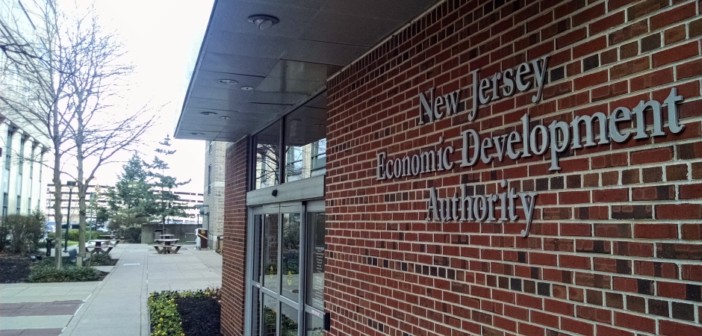The state Economic Development Authority proposed altering its benefits calculations to keep companies that get tax incentives from leaving the state early.
By Matt Skoufalos | December 13, 2016
Companies that relocate to New Jersey to receive benefits from the state Economic Development Authority (EDA) soon could be required to either sign longer-term commitments to stay, or risk forfeiting incentives they may have earned by leaving early.
The board approved the proposed rules change unanimously at its December 13 meeting in what EDA President and Chief Operating Officer Tim Lizura called an attempt to “catch up and clean up the model” upon which those benefits are calculated.
“I think it’ll be more accurate, and that’s what we’re shooting for,” Lizura said.
Under its Economic Redevelopment and Growth (ERG) and Grow NJ programs, the EDA awards corporations incentives based upon assumptions of the prolonged economic benefit generated by their business operations.
This calculus hinges on regional economic assumptions that Lizura said were developed “several years ago,” and which do not reflect current market conditions—namely, an October 2016 5.2-percent unemployment rate, a November 2016 six-year high in private-sector jobs, and the record number of new business applications received by the state in 2015.
ERG and Grow NJ awards are offered for 1.5 times the number of years a corporation commits to remain in New Jersey. To earn a 10-year benefit award, for example, a company must operate in the state at a sustained employment and salary level for 15 years. That benefit is further incentivized in distressed places like Camden City, where EDA calculates benefit awards for as many as 35 years with a 20-year commitment.
Yet companies receiving lengthy awards have no statutory obligation to stay in New Jersey beyond year 15, even as the economic benefits of their operations are projected out for twice as long. That means that the bigger—and longer-term—the deals that are awarded, “the less certainty exists with regard to the ongoing benefits,” Lizura wrote in a memo.
The new methodology adopted Tuesday changes that.
Companies receiving incentives calculated on a 30- or 35-year award must sign an agreement with the EDA to sustain their operations in New Jersey at the same employment and salary level for the full term upon which their benefits are calculated.
If not, the EDA will assume the state gains zero economic impact from such businesses, aside from real estate taxes, from year 16, and will adjust the award accordingly.
“From year 15 to termination date, we recommend stripping out the corporate direct and indirect activity from the analysis, with the exception of keeping property taxes,” Lizura told the board. “The building will be there; the employer may not be.”
The changes would also permit the EDA to recoup a portion of benefits awarded to companies that violate an extended-term commitment. In an example given in the memo, if a corporation committed to a 20-year stay in Camden City, but relocated by year 17, the EDA could claw back benefits extrapolated for years 18, 19, and 20.
“Everyone who gets the maximum-length [award]has to commit to stay,” Lizura said. “The company could make a statement that they’re willing to commit for 20 years; 30, 35. If they’re willing to make that commitment, we would give a calculation for each year that the company would have to repay if they left before that new commitment occurred.”
The same statute could also enrich the benefits of projects that might have been calculated at a lesser rate because of a shorter projected length of term, Lizura said. In all cases, the impact of the benefit is tied to the wages and salaries of jobs created, meaning that companies creating higher-paying jobs will net a greater benefit.
“This is a more refined model for better projections,” Lizura said. “We believe that this is better representation of what we can expect.”
The rule changes will head for a public comment period, and the revised model will take effect for ERG and Grow NJ applications received on or after February 16, 2017.
Applications already in process and those received prior to that date will be calculated under the prior models, unless analysis results in a 25-percent-or-more change in the project. All modification requests approved after June 13, 2017 will be evaluated under the new model, an EDA spokesperson said.
In places like Camden City, however, critics said the changes don’t go far enough to fix a system that is offering lopsided benefits to companies that are only expected to break even, rather than to outperform the incentive.
A May 2015 report from New Jersey Policy Perspective (NJPP) calls for stronger legislative reforms to reduce the risks borne by New Jersey taxpayers under the current arrangement.
In a statement distributed Tuesday, NJPP Vice President Jon Whiten praised the EDA for being willing to refine its approach to corporate benefits, but argued that the executive and legislative branches of the state should write stricter laws governing their disbursement.
“When it comes to this net benefits test, the legislature should follow the EDA’s lead and restore some fiscal responsibility and realism to the test,” Whiten wrote. “The easiest and most sensible way to do so would be to ensure that the net benefits test covers only the number of years the corporation is committed by statute to stay in the state, as legislation introduced by Assemblyman Troy Singleton would do.”
Additional EDA reforms Whiten said he’d like to see include benefit caps, improved reporting on the outcomes of the aid administered, and “more stringent standards for subsidies given to corporations shifting jobs around the state, and restricting corporations’ ability to redeem more in tax credits than they owe in taxes.”
In the case of Camden City, the levers of economic policy at the EDA are not a cure-all for the challenges that come with revitalizing its housing stock, public safety, and access to education at all levels, Lizura said.
He argued that corporate incentives are helping address conditions that resulted from 50 years of economic stagnancy, a trend that would not reverse itself without outside intercession and a similarly long timeframe to correct.
“I think it’s fairly clear that companies were not investing in the city prior to [these programs],” Lizura said. “Private institutions did not invest. Corporations left, and left dilapidated buildings.
“We have to change that paradigm with an economic conversation,” he said. “Even now, we’re standing on the shoulders of the work that was done on the ERB (Economic Recovery Board), when there was investment in the eds and meds that was both trustworthy and capable.”
When projects like the billion-dollar Liberty Property Trust waterfront redevelopment come online amid greater neighborhood stability, they can create the type of interest that will natively draw corporate investment, Lizura said.
“You have to have those basic building blocks, and then you can have a conversation with a corporation,” he said. “The moment you can make that compelling financial case, you can start reversing that trend.
“If it was easy, it would be fixed.”
Get more local news that matters. Check out NJ Pen on Facebook and Twitter, or click here to become a supporter.








